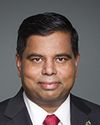I've been a nurse for 13 years now. My mother was a nurse as well. I think in the 13 years I've been practising, the jurisdictional issues have been there. They're not as bad as when I first started, and in defence of the First Nations Health Authority, that whole transformation in the delivery of services from the nursing perspective has not fully happened yet.
I know the conversation is still happening, and they're working really closely with the provincial health authorities. My whole cup is beyond half full around those changes occurring and pushing that change to happen, but yes, issues do still occur.
As for what I'd say you should recommend, I think all the other provinces and territories across the country don't have the same privilege we do as the First Nations Health Authority to go through that transformation stage.
As for FNIHB, the First Nations and Inuit Health Branch, I've never been a part of that organization federally, as a staff member or in discussion. I don't know how often they revisit that.
My interpretation of services coming in and being delivered to first nations communities is just “We're here, and we will do it this way.” There was no discussion. There was no dialogue. There were no negotiations. There was no needs assessment. Historically, for generations, it has been this way. I think it's changed a little bit over my time, but I think it needs to change a lot more. If we want full empowerment and ownership of our health, we need to be able to have that conversation with whoever is delivering those services to us.




